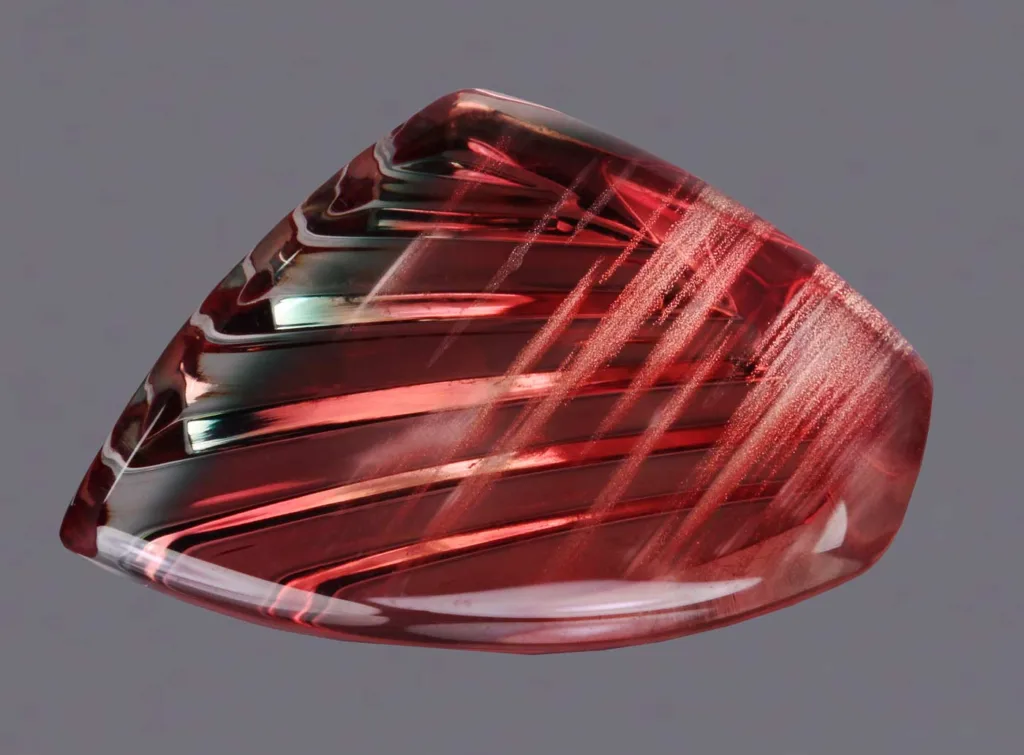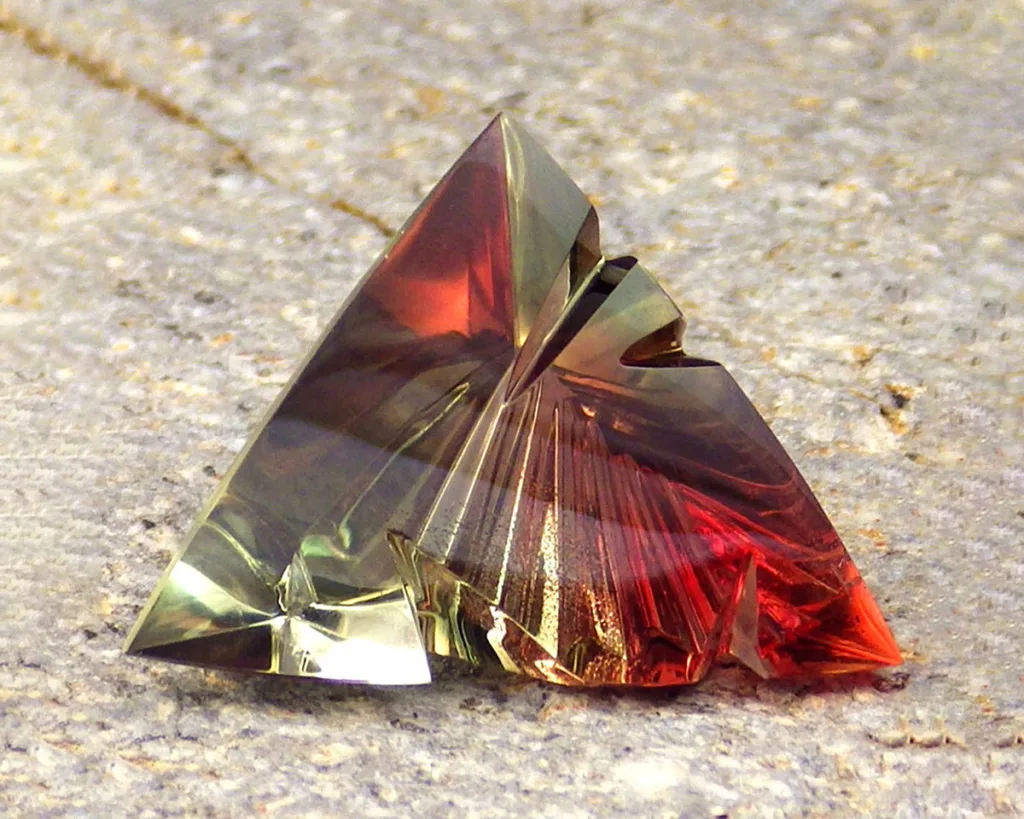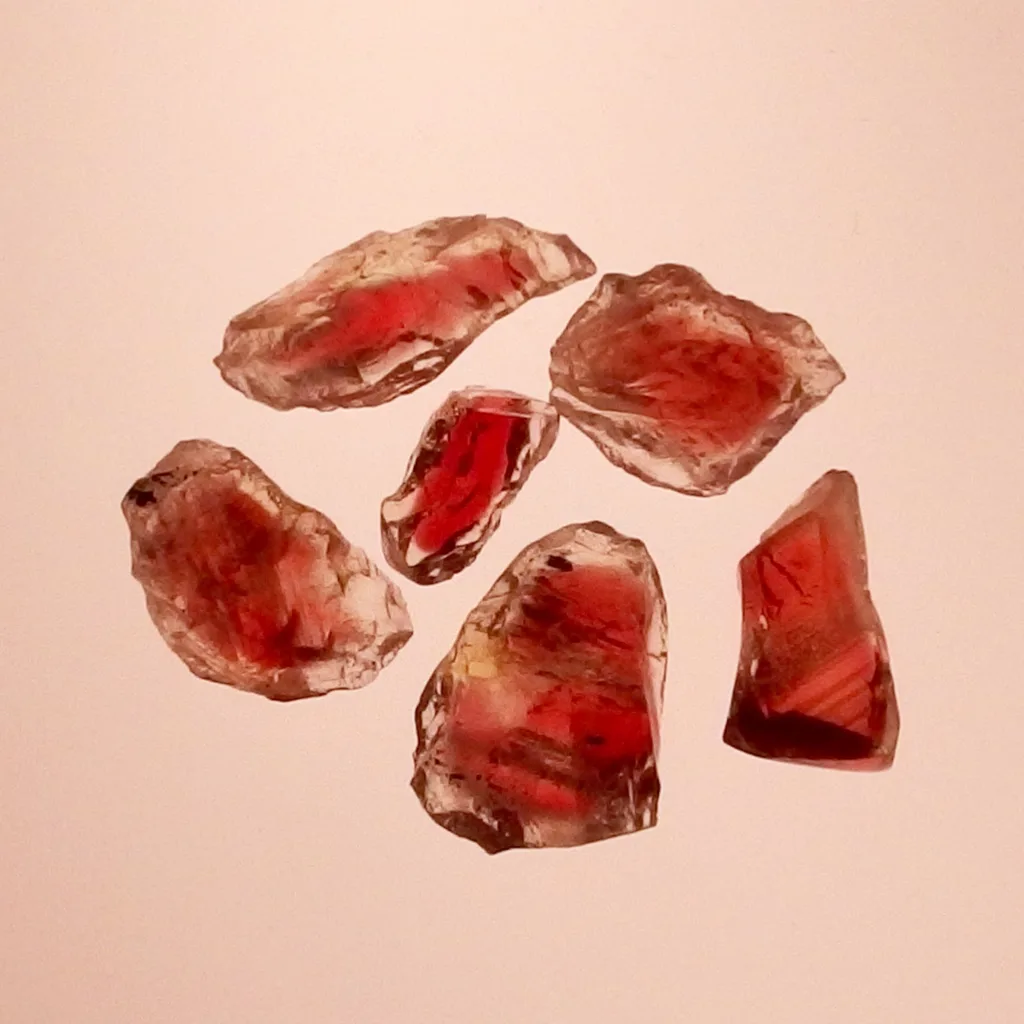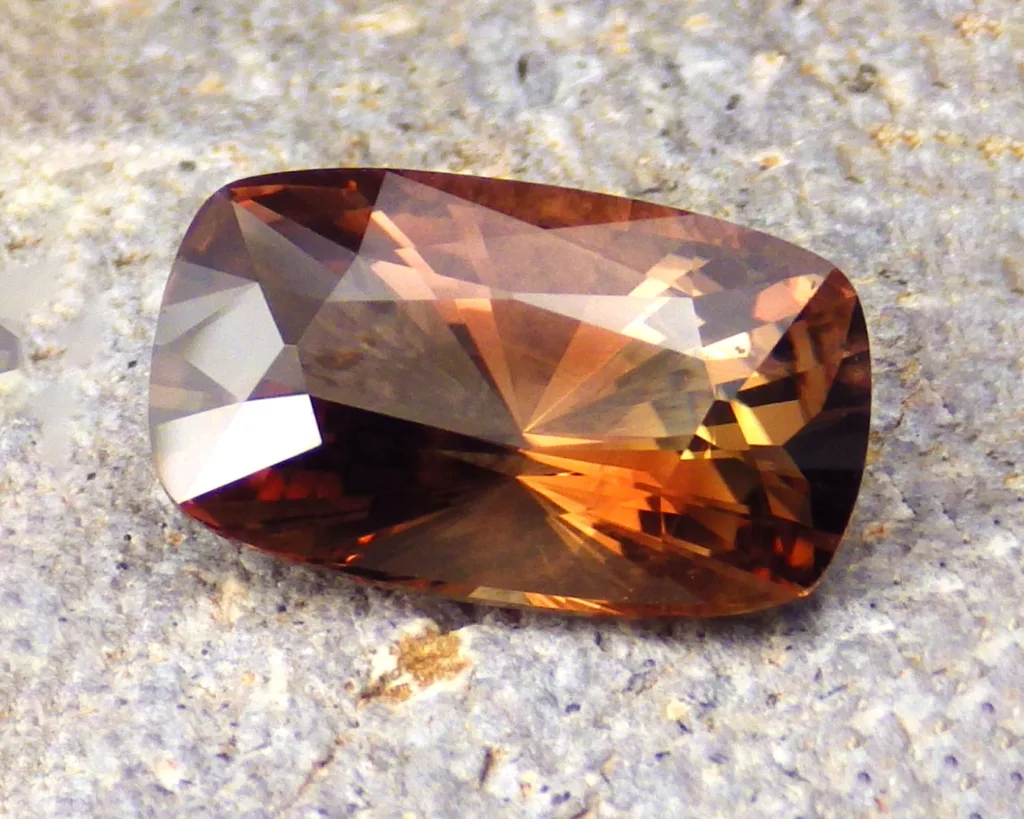Oregon Sunstone is a unique variety of feldspar gemstones known for their captivating play-of-color, ranging from golden hues to fiery reds and oranges. These gemstones derive their name from the state of Oregon in the United States, where they are primarily found.

Sunstones are formed within lava flows, particularly in the high desert region of southeastern Oregon, where they are discovered embedded in basalt. The vibrant colors within the stone are often caused by copper inclusions, which create the optical phenomenon known as aventurescence. This effect gives the gemstone its distinctive shimmer and iridescence, resembling the sun’s rays glimmering on the surface of water, hence the name “Sunstone.”
In the gemstone market, Oregon Sunstones hold a significant place due to their unique appearance and rarity. Their distinct play-of-color and natural beauty make them highly sought after by collectors, jewelry designers, and gem enthusiasts. They are often used as centerpieces in jewelry pieces such as rings, pendants, and earrings, adding a touch of warmth and brilliance to any design.

Oregon Sunstones are also valued for their metaphysical properties, believed by some to enhance creativity, vitality, and positive energy. This adds to their appeal among those who seek gemstones not only for their aesthetic qualities but also for their perceived spiritual or healing properties.
Overall, Oregon Sunstones stand out in the gemstone market for their captivating appearance, rarity, and cultural significance, making them a cherished and desirable addition to any gem collection or jewelry collection.
Geological Formation

Oregon Sunstones are formed through a combination of geological processes involving volcanic activity and the cooling of molten rock. Here’s a brief overview of their geological formation:
- Volcanic Activity: Oregon Sunstones are primarily found in the high desert region of southeastern Oregon, which was shaped by extensive volcanic activity millions of years ago. During volcanic eruptions, molten rock, or magma, rises from the Earth’s mantle and reaches the surface, forming lava flows.
- Lava Flows: As lava flows across the landscape, it cools and solidifies to form igneous rocks, such as basalt. Basalt is rich in minerals like feldspar, which is crucial for the formation of Sunstones.
- Intrusion of Plutons: Within the basaltic lava flows, pockets of magma, known as plutons, may intrude. These plutons can contain a variety of minerals, including feldspar. As the magma cools slowly underground, it allows crystals to form, including the feldspar crystals that give rise to Sunstones.
- Formation of Sunstone Crystals: Within these pockets of magma, conditions are conducive for the growth of feldspar crystals. The presence of specific elements, such as copper, within the magma can lead to the formation of inclusions and coloration within the feldspar crystals, resulting in the distinctive play-of-color seen in Sunstones.
- Weathering and Erosion: Over time, weathering and erosion expose the Sunstone-bearing rocks at the Earth’s surface. These weathering processes break down the surrounding rock and release the Sunstone crystals, which are then collected by miners.
The unique geological conditions in southeastern Oregon, characterized by ancient volcanic activity and the presence of specific mineral-rich magmas, contribute to the formation of Oregon Sunstones. Their rarity and distinctive appearance make them prized gemstones in the world of jewelry and gem collecting.
Physical Properties

Oregon Sunstones possess several physical properties that contribute to their unique appearance and allure. Here are some of the key physical properties of Oregon Sunstones:
- Composition: Oregon Sunstones are primarily composed of a variety of feldspar known as oligoclase, with additional trace elements contributing to their color and optical effects. These trace elements, such as copper, are responsible for the distinctive play-of-color and aventurescence seen in Sunstones.
- Color: Sunstones exhibit a wide range of colors, including golden yellows, fiery oranges, and reddish-browns. The most prized Sunstones often display a vibrant play-of-color caused by light reflecting off microscopic copper inclusions within the feldspar crystals.
- Transparency: Oregon Sunstones typically have a transparent to translucent clarity, allowing light to pass through the gemstone. This transparency enhances the play-of-color effect, creating a mesmerizing shimmer and iridescence.
- Mohs Hardness: Sunstones have a moderate hardness of around 6 to 6.5 on the Mohs scale, making them suitable for use in jewelry. While they are relatively durable, care should be taken to avoid scratching or chipping the gemstone during wear.
- Crystal Structure: Sunstones belong to the feldspar group of minerals and have a triclinic crystal structure. This crystal structure contributes to their unique optical properties, including the play-of-color and aventurescence that make Sunstones so captivating.
- Cleavage: Sunstones exhibit good cleavage in two directions, which means they have a tendency to break along certain planes. This characteristic influences how Sunstones are cut and faceted to maximize their brilliance and minimize the risk of cleavage-related fractures.
- Specific Gravity: The specific gravity of Oregon Sunstones typically ranges from 2.64 to 2.68, which is slightly higher than the average for feldspar minerals. This property helps gemologists and jewelers distinguish Sunstones from other gemstone varieties based on density.
These physical properties collectively contribute to the allure and desirability of Oregon Sunstones in the gemstone market. Their unique play-of-color, transparency, and moderate hardness make them prized gemstones for use in jewelry and decorative objects.
Occurrence and Locations

Oregon Sunstones are primarily found in the United States, specifically in the state of Oregon, which is renowned for its rich deposits of these unique gemstones. The majority of Sunstone mining activity in Oregon occurs in the high desert region of southeastern Oregon, particularly within Lake County and Harney County. Here are some key locations where Oregon Sunstones are found:
- Plush and Rabbit Basin: Plush and Rabbit Basin, located in Lake County, Oregon, are well-known areas for Sunstone mining. These regions are situated within the broader Oregon Sunstone Public Collection Area, where visitors can pay a fee for access to designated mining areas and search for Sunstones.
- Sunstone Butte Mine: The Sunstone Butte Mine, located near Plush in Lake County, is one of the most famous Sunstone mines in Oregon. It has produced high-quality Sunstones with vibrant colors and excellent clarity.
- Ponderosa Mine: The Ponderosa Mine, located in Harney County, Oregon, is another notable Sunstone mining area. This mine has yielded Sunstones with various colors and sizes, including some exceptional gem-quality specimens.
- Dusty Rose Mine: Situated near Plush in Lake County, the Dusty Rose Mine is renowned for its Sunstones with a distinctive reddish hue. These Sunstones are highly prized by collectors and jewelry designers for their unique coloration.
- Double Eagle Mine: The Double Eagle Mine, also located in Lake County, is known for producing Sunstones with bright, golden colors and exceptional clarity. It is a popular destination for gemstone enthusiasts seeking high-quality Oregon Sunstones.
- Other Locations: In addition to these major mining areas, Sunstones can be found in various other locations throughout southeastern Oregon, particularly in areas with ancient volcanic activity and basaltic lava flows.
Overall, southeastern Oregon is the primary region for Sunstone mining in the United States, with numerous mines and collection areas offering opportunities for gemstone enthusiasts to explore and discover these captivating gemstones. However, it’s important to note that Sunstone mining in Oregon is regulated, and collectors must obtain permits or access to designated public collection areas for legal mining activities.
Uses

Oregon Sunstones have a variety of uses, ranging from jewelry to metaphysical purposes. Here are some of the main uses of Oregon Sunstones:
- Jewelry: One of the primary uses of Oregon Sunstones is in jewelry. These gemstones are cut and faceted into various shapes, such as cabochons, faceted stones, and beads, to be incorporated into rings, earrings, necklaces, bracelets, and other types of jewelry. Sunstones’ vibrant colors and unique play-of-color make them popular choices for creating eye-catching and distinctive jewelry pieces.
- Collector’s Items: Oregon Sunstones are highly sought after by gemstone collectors due to their rarity, unique appearance, and the geological significance of their origin. Collectors often seek out exceptional specimens with intense coloration, clarity, and play-of-color to add to their collections.
- Metaphysical and Healing Properties: Some individuals believe in the metaphysical properties of gemstones, including Sunstones. They are thought to possess properties such as promoting vitality, creativity, and positive energy. Sunstones are sometimes used in crystal healing practices or carried as talismans for their purported beneficial effects on mood and well-being.
- Lapidary Arts: Sunstones are valued by lapidaries and artisans for their beauty and versatility in various lapidary arts. These gemstones can be carved, sculpted, and polished to create decorative objects, sculptures, and ornamental pieces.
- Decorative Objects: Sunstones are sometimes used to adorn decorative objects such as lamps, vases, and figurines. Their vibrant colors and play-of-color add visual interest and elegance to these items, making them attractive decor accents for homes and offices.
- Educational and Research Purposes: Oregon Sunstones also serve educational and research purposes, providing insights into geological processes, mineralogy, and gemstone formation. Studying Sunstones helps geologists and researchers understand volcanic activity, mineral formation, and the Earth’s geological history.
Overall, Oregon Sunstones are versatile gemstones with a wide range of uses, from adornment in jewelry to applications in healing practices and lapidary arts. Their beauty, rarity, and cultural significance make them cherished gemstones appreciated by individuals around the world.




































